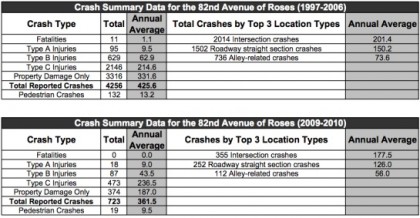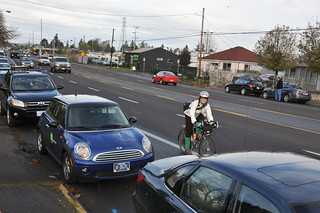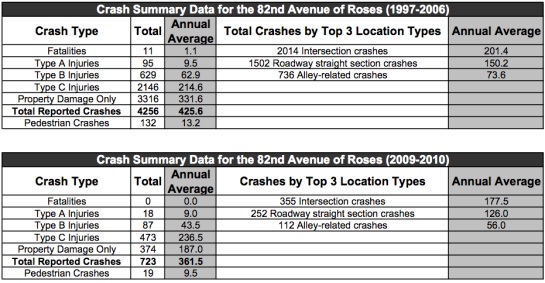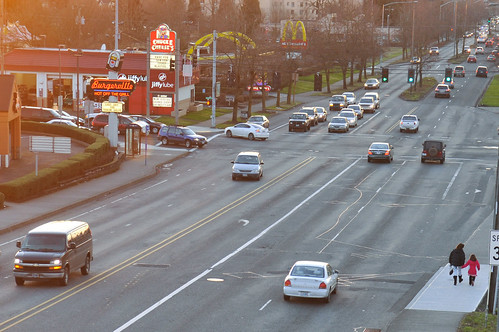
(Photos © J. Maus/BikePortland)
The Portland Bureau of Transportation (PBOT) is getting ready for the third year of the High Crash Corridor Program. The program (funded to the tune of $472,000 in this year’s budget), launched with a press conference in 2010 headlined by former Mayor Sam Adams, aims to tame traffic, educate the community, and improve safety on Portland’s large arterial streets.
It’s a well-worn truth among planners and advocates that a majority of fatal traffic collisions in our city occur on wide, high-volume, and/or high-speed streets known as arterials. PBOT data shows that just a small portion of the city’s 1,300 miles of arterials account for a majority of all collisions. 66% of Portland’s fatal collisions that involve someone walking and 52% of people who die in bicycle collisions occur on these streets. Despite the human toll, these arterials divide communities, prevent people from walking and biking, and have a host of other harmful impacts.
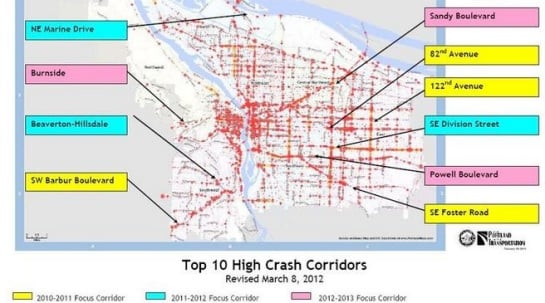
This year, PBOT has identified three streets to concentrate their safety efforts: W/E Burnside, SE Powell Blvd, and NE Sandy Blvd. These are just three of the top ten high crash corridors the agency identified when the effort launched in 2010. The others are: NE Marine Drive, Beaverton-Hillsdale Hwy, SW Barbur Blvd, 82nd Ave, 122nd Ave, SE Division, and SE Foster Rd. These streets have the highest serious crash rate per road mile and per mile traveled in the entire Portland metro region. With frequent transit service and lots of destinations, these streets also see a lot of street life (as we noted in a dispatch from SE Foster yesterday).
We reached out to PBOT’s High Crash Corridor program manager Clay Veka to learn more about what’s in store for the three 2013 focus corridors. She says they’ve already planned open houses for each of them:
- Sandy: 3/6/13, 6:30-8:30pm, Hollywood Senior Center
- Burnside: 2/27/13, 6:30-8:30pm, Buckman School Cafeteria
- Powell: targeting Summer 2013, location TBD
The effort will include a variety of activities that fall under the “three Es” of enforcement, engineering, and education. Veka says once they’ve done initial analysis and developed an existing conditions report, they’ll look implement “low-cost, rapid response engineering improvements” (that’s PBOT’s way of saying they have a very limited budget). These will be things like pavement markings, signage, changing signal timing, and so on.
PBOT assigns a “pedestrian educator” to work with the community through training sessions and other outreach activities. To tame auto traffic and to raise awareness about how to walk safely, PBOT will do enforcement actions in partnership with the police. They’ll also do little things like make sure ADA curb ramps are in place and remove graffiti and cut back vegetation from signs if necessary.
Since the budget for this program is small (it’s paid for by ODOT, Metro, and TriMet) (*see note below), at the end of the process, Veka says PBOT will develop a report with recommendations for long-term engineering improvements that will be installed once funding becomes available.
Of course the important question is — does all this actually make a difference? With the program being relatively new, a complete picture still hasn’t come into focus; but preliminary stats from 82nd Ave look very promising. As you can see in the chart below, nearly every crash-type has seen a decrease based on data from 2009-2010 versus data from 1997-2006.
Portland is often heralded as a utopian city and a beacon of livability. But these arterials cut right into that reputation. We must figure out how to make these streets more humane and the High Crash Corridor Program is a great opportunity to begin that process. Learn more via PBOT’s website.
*Note: I made an error in the original story. Funding for this program comes from PBOT’s budget. The total amount allocated for the program in the 2012-23 fiscal year is $472,640.
